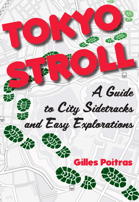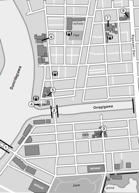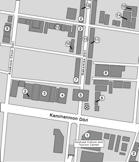











Tokyo Stroll Supplement: Nishitōkyō

This page is for locations in the Nishitōkyō area of Tokyo. This area is not part of my book Tokyo Stroll.
For information on Tokyo Stroll and this web supplement see Tokyo Stroll Supplement home page
For users of the Organic Maps, Maps.Me and Google Maps apps the items below have bookmarks you can import into those apps to make navigation easier.
Instructions and links are on the Viewing Locations in Organic Maps, Maps.Me, Google Maps, or Google Earth page.
Some entries on this page may include a note that says "Description to be added soon ." These entries are for items I felt should be listed even if the description is not ready to assist those who wish to plan a trip. When possible I included a link to an official web page, I suggest also doing web searchs for more information.
Nishitōkyō Shi (西東京市)
Nishitōkyō was created by the merger of the towns of Hōya-shi & Tanashi-shi in 2001. Two rail lines run through Nishitokyo, the Seibu Ikebukuro Line and the Seibu Shinjuku Line. Today much of the population consists of commuters who use the two rail lines go to the 23 ku area to work.
Official pages for each of the cities and towns of will have sections of interest to visitors. These will likely be labeled as dealing with culture, tourism, or events.
Nishitōkyō Shi official site: http://www.city.nishitokyo.lg.jp
Higashi-Fushimi Inari Shrine / Higashi-Fushimi Inari Jinja(東伏見稲荷神社)
A large shintō shrine built in 1929 as a branch of the famous Fushimi Inari Jinja in Kyoto. The kami enshrined here are Ukanomitama no Ōkami, Sadahiko Ōkami, and Omiyanome no Ōkami. Behind the main shrine there are 18 sub-shrines each approached through rows of smaller torii. Some of the rows of torii meet up forming a bit of a maze to explore. The nearby Higashi-Fushimi Station was originally called Kamihoya station. The station name was changed after the shrine was built.
NEAREST TRAIN/SUBWAY STATION: Higashi-Fushimi Station (Seibu Shinjuku Line)
ACCESS: Entrance to the south marked by a very large torii and two large red and green lanterns. This is followed by a series of steps leading to large fox statues and the shrine gate. To the right of the entrance is a drive way that leads to the shrine parking lot close to buildings.
WEB: http://www.higashifushimi-inari.jp
Nyoirinji (如意輪寺)
A Shingon Buddhist temple of the Chisan sect which is also called Hōya Kannon (保谷観音). The main statue is of Nyoirin Kannon.
NEAREST TRAIN/SUBWAY STATION: Hibarigaoka Station (Seibu Ikebukuro Line)
PILGRIMAGE: This temple is on the Musashino Kannon Pilgrimage
ACCESS: One can enter the grounds from the east, there is a gate to the south which is not always open.
Tanashi Shrine / Tanashi Jinja (田無神社)
Founded in the Kamakura Period, not far north of the present location, then the shrine was called Jōdono Gongen and associated with water hence the shrine being associated with dragons. The shrine was relocated to the present site in 1670 to be close to the new Ōme Kaidō Road. In the mid 19th century the Edo Period sculptor Shimamura Shunpyō over a two year period carved much of the woodwork. In 1872 during the Meiji Period separation of Buddhism and Shintō the name of the shrine was changed to Tanashi Jinja. Later other locals shrines were merged with this one, a common process in the Meiji Period which reduced the number of local shrines in much of Japan. The shrine was heavily damaged during the Great East Japan Earthquake in 2011 and carefully restored. There is a statue on the grounds of the famous general Masashige Kusunoki who backed Emperor Go-Daigo in his struggle against the Kamakura shōgunate. The statue is quite worn, apparently people about to go off to war would chip away a small amount as a talesman. People pray at Tanashi Jinja for recover from injury or illness, also for success in academics, and business.
NEAREST TRAIN/SUBWAY STATION: Tanashi Station (Seibu Shinjuku Line)
FESTIVALS: Numerous festivals are held throughout the year at the shrine, check their web page for details.
WEB: https://www.tanashijinja.or.jp
Tamarokuto Science Center / Tamarokuto Kagakukan (多摩六都科学館)
An interactive science museum consisting of five large rooms and one of the largest planetariums in the world. The Tamarokuto Science Center is a joint project of the cities of Kodaira, Higashimurayama, Kiyose, Higashikurume and Nishitokyo. Exhibition Room 1 "Meet the Science" has several exhibits demonstrating aspects of physics and a full-scale reproduction of the front part of NASA's Space Shuttle. Exhibition Room 2 "Body and Senses" Exhibits on human anatomy including the senses of hearing, sight, smell, and touch. Exhibition Room 3 "System and Mechanism" Exhibits on several mechanisms, such as a piano, clock, power generation, and the infrastructure of electricity, water, and sewage necessary in our communities. Exhibition Room 4 "Life and Environment" Exhibits on animals incorporating models, as well as live and mounted specimens. There are also exhibits on plants and a dioramas of local scenery and wildlife. Exhibition Room 5 "Geoscience" Local geology, mineral specimens that can be handled, fossils and local fossil hunting. There is also a spacious lounge with vending machines where you can also enjoy any food you brought with you.
NEAREST TRAIN/SUBWAY STATION: Hana-Koganei Station (Seibu Shinjuku Line)
CLOSED: Mondays unless Monday is a holiday then closed Tuesday. New Year's holidays.
WEB: https://www.tamarokuto.or.jp/english/
Back to the Tokyo Stroll Supplement home page - Privacy Notice - Back to Gilles' home page
Created June 11, 2024 | Content last updated April 19, 2025